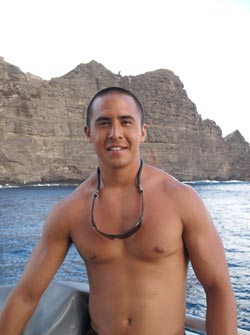
2011 Papahānaumokuākea Intertidal Monitoring Cruise Survey Team Reflections: Patrick Springer – Protect Papahānaumokuākea ʻOhana
Aloha, my name is Patrick Springer, and I grew up on the Big Island, in Puna and Hilo. The ocean has always been a special place for me. I remember it began with my parents taking me to Kaimu as a young boy and wishing that we would never have to leave. I enjoy fishing, diving, surfing, and sailing waʻa in my free time, however in the last five years or so, volunteering my time to monitor and conserve our resources continues to become a more important part of my life.
I started volunteering with intertidal surveys as a part of my wife's master's degree work, which happened to be on ʻopihi. I work for the Hawaii Fire Department as a Paramedic, which, lucky for me, makes my presence welcome while conducting work in the intertidal zone. All my life the ocean has fed and nurtured me, washed away my troubles, made me smile, and most important, taught me respect. To me, we must give back to the sea for all it has given to us.
I have been privileged to be a part of this expedition to our kūpuna islands, and can say that it is an amazing place, rich and abundant in natural beauty and resources. Personally, it was a chance to see back in time to what our islands used to be like, to be able to have contrast.
I personally hoped to help support the different research objectives of this trip, and to practice culturally appropriate protocol. Our data we gathered will give us a clearer picture and understanding of the status of intertidal marine life in the Northwestern Hawaiian Islands (NWHI) and allow us to have a baseline for future research. On a personal level, this trip has served as motivation to continue my involvement in marine conservation. I would also hope to share this experience and what I have learned with other like-minded people back home.
I also felt that the other members of the expedition brought a unique and perfect mix of expertise. We were fortunate to have scientific experts in the areas of tidepools, intertidal invertebrates, and algae with us. We also had community members who were lifetime fisherman and conservationists who were intimately familiar with the ocean. During these two weeks, we all taught and learned from each other, yet with that in mind, between the nine of us there are so many unknowns, and there is much more learning and research that needs to be done. Ideas were exchanged and personal connections were established which will lead to future collaborations. I found it amazing that among nine people, there were no egos and no conflict, just one team working for a common goal.
One purpose of our trip was to take inventory of Papahānaumokuākea's marine life in the intertidal zone. On direct personal observation, I have taken note that there are some places in the Main Hawaiian Islands that are almost as healthy and equally remarkable. Other places are sad indicators of intertidal marine ecosystems in crisis.
I can say for a place like my island, Hawaiʻi, we have a large population, but we also have an extensive, rugged, and diverse coastline that is capable of providing for those who live there. The lesson is that what determines the health of our future marine resources depends on if our population, as a community, decides to be a part of the problem or part of the solution. I think a large part of that has to do with educating our peers and setting an example for future generations.
I feel everyone who grew up in Hawai'i has heard not to turn your back on the ocean, and this is an expression that should be taken in a much broader sense regarding marine resource management; as that of not turning one's back out of ignorance, complacency, or selfishness. Whether doing 'opihi research or harvesting ʻopihi, turn a blind eye to the sea, and it will humble you. We as a community need to face the ocean, work together, and help to solve the problems we have created.
Lastly, one moment I will always remember was at Nihoa Island, where we were blessed with beautiful scenery and hot, sunny weather. After a long day of research, I squeezed up a batch of 'awa, of which I offered up the first apu to Nihoa and Kanaloa. I then presented apu to each of our team members who were present, and after the first round of 'awa, we noticed a rainbow, directly overhead. This was no ordinary rainbow. It was directly overhead, no rain was falling on us, and it appeared as if it had been turned horizontally on its side. I have never seen anything like it in my life. For me, it was affirmation that our presence, our intentions, and the work we were doing was approved of, and pono.
Click Here for more Survey Team Reflections.
